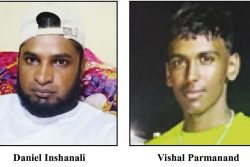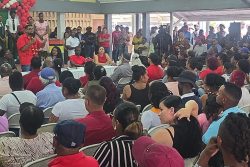Just over two months after the administering of the first COVID-19 vaccine on February 11th to a health worker, the government announced that inoculations would be available to all persons over 18. The first such vaccinations were done on April 16.
The opening up of vaccinations to all persons above 18 is undoubtedly a bold move by the government. It comes in the wake of two realities that have been observed on the ground. The first of these is that there appears to be significant hesitancy to taking the vaccines. In the earlier phase of vaccinations where over-60s and health workers were to be catered for, the numbers of persons lining up were quite small. Even when the age eligibility was lowered to 40 and above the vaccination centres were still not fully subscribed.
In daily conversations, one hears about reservations to taking the jabs particularly as it relates to the clotting concerns that surround AstraZeneca and now Johnson and Johnson’s much vaunted single-dose vaccine. While Denmark became the first country to completely abandon plans to use AstraZeneca, the World Health Organisation (WHO) and regulatory authorities around the world have advised that the risk of clotting is minuscule and that the benefit of being inoculated against COVID is far more important.
On March 19th, the WHO said that based on a careful scientific review of the available information, its subcommittee on vaccine safety came to the following conclusions:
* The AstraZeneca COVID-19 vaccine (including Covishield) continues to have a positive benefit-risk profile, with tremendous potential to prevent infections and reduce deaths across the world.
* The available data do not suggest any overall increase in clotting conditions such as deep venous thrombosis or pulmonary embolism following administration of COVID-19 vaccines. Reported rates of thromboembolic events after COVID-19 vaccines are in line with the expected number of diagnoses of these conditions. Both conditions occur naturally and are not uncommon. They also occur as a result of COVID-19. The observed rates have been fewer than expected for such events.
This position has also been adopted by the European Medicines Agency and the UK’s Medicines and Healthcare products Regulatory Agency
Resistance to the vaccines here has also been fuelled by the fictions and myths circulated on social media which have tended to be adopted even by the well-meaning and spread far and wide. The number of deaths here from the pandemic up to yesterday was 271. That is no fiction and the figure is probably even understated. The coronavirus (SARS-CoV-2) poses a lethal risk to Guyanese in several categories and the vaccines presently available provide the best known means of not becoming infected. Even where after vaccination people have become infected, experts say that the infection is milder and doesn’t require hospitalisation.
Another reason behind the decision to drastically lower the age eligibility is the increasing numbers of Guyanese in the 30 to 40 age range who have contracted the virus and died after experiencing a sudden health crisis. The increased lethality and invasiveness of the virus is believed to be linked to the COVID-19 variants that have spread prodigiously. In Guyana’s context, Brazil’s P.1 variant which could possibly have emerged from Manaus is believed to be twice as transmissible as the original strain of the virus and could perhaps more easily get by immune defences in the body.
As of yesterday, Brazil had recorded 67,636 additional confirmed cases of the coronavirus in the preceding 24 hours, along with 2,929 deaths. In total, Brazil has registered more than 13.9 million cases since the pandemic began and the official death toll has risen to 371,678. These figures underline the grave threat posed to Guyana and the decision last week of the authorities in Aishalton in Region Nine to impose a lockdown after the reporting of a number of cases.
It is disappointing that after an initial test of samples for variants by the Caribbean Public Health Agency that the Ministry of Health has not had such testing done routinely to establish if variants are here and if so which ones and whether that required a return to stricter lockdown measures. With the increasing death toll, the Ministry of Health has also been silent on whether its interventions for severely ill patients are the current best practices and whether it has an adequate supply of the recommended therapeutics for ICU patients.
Now that it is vaccinating all willing persons over the age of 18, the ministry now faces the real challenge of acquiring sufficient numbers of vaccines to ensure there is no interruption in inoculations. It has been estimated that at two jabs per person, Guyana would initially need 1 million doses to enable it to arrive at the desired herd immunity. If tens of thousands of persons come forward to be vaccinated the Ministry’s supply of first-dose vaccines could be easily exhausted raising the prospect that vaccines set aside for the second dose may be utilised in anticipation of further arrivals.
To date, Guyana has received donations of 3,000 AstraZeneca (AZ) vaccines from Barbados, 20,000 Sinopharm vaccines from China and 80,000 AZ vaccines from India. Guyana in turn donated 5,000 shots from the Indian donation to Barbados. Guyana has also received 55,000 shots of Sputnik V that it purchased and 24,000 doses of AZ through the COVAX mechanism. All of the vaccines acquired so far require two shots to be administered per person. It would mean that Guyana has received enough vaccines to fully inoculate – two shots each – 88,500 persons. The Minister of Health, Dr Anthony during his COVID-19 update last week said that some 83,000 doses of the Russian Sputnik V vaccines are expected to arrive this week after having been delayed last week. This shipment will cater for full inoculation of another 41, 500 persons which means that 130,000 persons are fully catered for leaving roughly 370,000 more persons in the target group and 740,000 vaccines to acquire.








